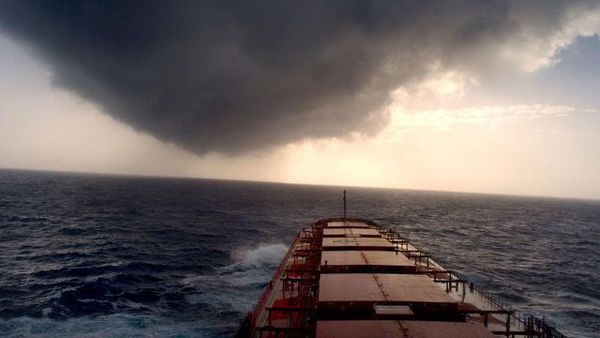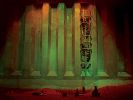Eye For Film >> Movies >> Dead Slow Ahead (2015) Film Review
Dead Slow Ahead
Reviewed by: Rebecca Naughten

The opening titles of Dead Slow Ahead tell us that we are to embark on "a sea journey shot on [the ship] Fair Lady" but that is a reductive description of the experience that results from Mauro Herce's camera searching within the quotidian for the abstract and the strangely unsettling, onboard a cargo ship during several months at sea. Not dissimilar to the aesthetic and aural concerns of Félix Dufour-Laperrière's occasionally dream-like essay film Transatlantique (2014), Herce's directorial debut nonetheless creates a more nightmarish and menacing vibe through its exploration of the sounds and sights onboard a working ship.
In fact, the start of the film recalls the opening of documentary The Iron Ministry (J.P. Sniadecki, 2014), as an environment-encompassing soundscape is built up through the mechanical cacophony of metallic shrieks, rumbles and drones, and places us deep within the belly of a different type of iron beast. But the constant beeping - an electronic pulse that sometimes scatters as if bouncing off all internal surfaces of the ship - gives proceedings a sci-fi feel. This is not least because, in conjunction with the initial absence of human life, it generates an uneasy tension that leads the viewer to question where this journey is going - just out to sea, or into the future, to the end of the world?

What we see of the world outside of the ship likewise has an air of unreality. Hazy coastlines are shrouded in a chalky white mist like a chemical smog while elsewhere the lights of refineries sparkle in a high-tech horizon at night. Of the many spectacular seascapes witnessed, one shot captures a beam of moonlight cutting through the clouds to illuminate the surface of the nighttime sea like a spotlight... or a light from a spaceship. The choices made in the presentation of the ship play into this alienness, not simply via the static shots of empty corridors and mess rooms or the close-ups of the robotic movements of the cranes and diggers, but also through the abstract manner in which Herce approaches the workers in their environment.
After the ship begins taking in water and the wheat cargo is damaged (the first time intelligible words are heard), the workers are dwarfed by the size of the hold as they start trying to move the wheat out of the water's path and are rendered ant-like and anonymous by the immensity of the architectural space. A nightmarish vibe comes to the fore, this time through the garish green and red effect of the lighting - evoking the oxidation of metals, foregrounding the industrial materials alongside the industrial scale - within the space.
But there is also a disconnect between the sight of the workers and human sound. For example, a sequence at a karaoke session keeps the singer we can hear out of view until the sound switches to the mechanical goings-on out on deck. Or later, on a series of long-distance family phone calls - which emphasise the geographical vastness in which this lone ship is moving, isolated beyond the reach of reliable telecommunications - play as disembodied voices while the camera peruses the ship's labyrinthine pipework. This disjuncture between sound and image where humans are concerned is suggestive of the workers being integrated into - or becoming interchangeable with - the workings of the ship. One element more in its slow and creaking mechanical progress to unknown destinations.
A director of photography of great talent (he was responsible for the crystalline beauty of Arraianos (Eloy Enciso, 2012)), it was perhaps to be expected that Herce's move into directing would produce such bold imagery but the attention paid to sound is just as rigorously detailed, creating a distinctive soundscape that envelopes the viewer in this maritime world. Together these elements combine into an immersive cinematic experience and an impressive directorial debut.
Reviewed on: 16 Dec 2015















